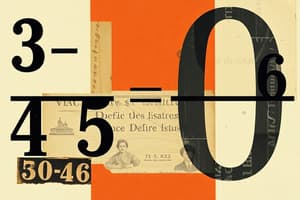Podcast
Questions and Answers
What is the first step when multiplying decimals?
What is the first step when multiplying decimals?
- Count the decimal places in the product.
- Place the decimal point in the result immediately.
- Convert the decimals to fractions before multiplying.
- Multiply the numbers as if they were whole numbers. (correct)
How do you determine the position of the decimal point in the product of two decimals?
How do you determine the position of the decimal point in the product of two decimals?
- It is positioned in the product before multiplying.
- Count the total number of decimal places in the factors. (correct)
- Position it at the end of the product.
- Place it based on the number of decimal places in the result.
What is the approximate result of multiplying 0.2857 by 178?
What is the approximate result of multiplying 0.2857 by 178?
- 53.9986
- 55.9986
- 50.9986 (correct)
- 49.9986
Why is it important to be mindful of decimal places during multiplication?
Why is it important to be mindful of decimal places during multiplication?
How is standard form represented in scientific notation?
How is standard form represented in scientific notation?
Flashcards
Multiplying Decimals
Multiplying Decimals
Multiplying decimals is like multiplying whole numbers, but you must consider the decimal places.
Decimal Place Count
Decimal Place Count
The number of digits after the decimal point in a number.
Decimal Point Placement
Decimal Point Placement
Place the decimal point in the product (answer) so the total number of decimal places is the sum of the decimal places of the factors.
Example: 0.2 x 0.3
Example: 0.2 x 0.3
Signup and view all the flashcards
Decimal Multiplication: Accuracy
Decimal Multiplication: Accuracy
Signup and view all the flashcards
Study Notes
Multiplication of Decimals
- To multiply decimals, first multiply the numbers as if they were whole numbers.
- Count the total number of decimal places in both the numbers being multiplied.
- Place the decimal point in the product so that the resulting number has the same number of decimal places as the sum of the decimal places in the factors.
Example Calculation: 0.06/0.21 * 0.89/0.005
-
Calculation 1: 0.06 / 0.21 = 0.060.21=621=27≈0.2857\frac{0.06}{0.21} = \frac{6}{21} = \frac{2}{7} \approx 0.28570.210.06=216=72≈0.2857
-
Calculation 2: 0.89 / 0.005 = 0.890.005=\frac{0.89}{0.005} =0.0050.89= 8905=178\frac{890}{5} = 1785890=178
-
Combining the two results: 0.2857 * 178 = 50.9986
-
Therefore, 0.06/0.21 * 0.89/0.005 ≈ 50.9986
-
To express this in standard form, we would need additional context. Standard form, also known as scientific notation, represents a number as a decimal between 1 and 10 multiplied by a power of 10. To determine the standard form, the result after multiplication needs to be converted to a format where there is a number between 1 and 10 being multiplied by some power of 10. Without a specific rounding requirement, the intermediate result can't be presented as a standard form.
-
The process of multiplication of decimals is important in many contexts, including financial calculations, scientific measurements, and everyday problem solving.
-
It's important to be mindful of the number of decimal places in the factors and the result when performing multiplications of decimals for accuracy.
Studying That Suits You
Use AI to generate personalized quizzes and flashcards to suit your learning preferences.




